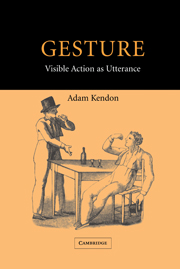Book contents
- Frontmatter
- Contents
- Acknowledgments
- 1 The domain of gesture
- 2 Visible action as gesture
- 3 Western interest in gesture from Classical Antiquity to the eighteenth century
- 4 Four contributions from the nineteenth century: Andrea de Jorio, Edward Tylor, Garrick Mallery and Wilhelm Wundt
- 5 Gesture studies in the twentieth century: recession and return
- 6 Classifying gestures
- 7 Gesture units, gesture phrases and speech
- 8 Deployments of gesture in the utterance
- 9 Gesture and speech in semantic interaction
- 10 Gesture and referential meaning
- 11 On pointing
- 12 Gestures of ‘precision grip’: topic, comment and question markers
- 13 Two gesture families of the open hand
- 14 Gesture without speech: the emergence of kinesic codes
- 15 ‘Gesture’ and ‘sign’ on common ground
- 16 Gesture, culture and the communication economy
- 17 The status of gesture
- Appendix I Transcription conventions
- Appendix II The recordings
- References
- Index
5 - Gesture studies in the twentieth century: recession and return
Published online by Cambridge University Press: 05 February 2015
- Frontmatter
- Contents
- Acknowledgments
- 1 The domain of gesture
- 2 Visible action as gesture
- 3 Western interest in gesture from Classical Antiquity to the eighteenth century
- 4 Four contributions from the nineteenth century: Andrea de Jorio, Edward Tylor, Garrick Mallery and Wilhelm Wundt
- 5 Gesture studies in the twentieth century: recession and return
- 6 Classifying gestures
- 7 Gesture units, gesture phrases and speech
- 8 Deployments of gesture in the utterance
- 9 Gesture and speech in semantic interaction
- 10 Gesture and referential meaning
- 11 On pointing
- 12 Gestures of ‘precision grip’: topic, comment and question markers
- 13 Two gesture families of the open hand
- 14 Gesture without speech: the emergence of kinesic codes
- 15 ‘Gesture’ and ‘sign’ on common ground
- 16 Gesture, culture and the communication economy
- 17 The status of gesture
- Appendix I Transcription conventions
- Appendix II The recordings
- References
- Index
Summary
Recession and its causes
Tylor, Mallery and Wundt well represent the interest that was taken in gesture in the latter half of the nineteenth century and the kind of significance that was attached to its study. Following in their wake we find that many scholars in the period extending into the second decade of the twentieth century included gesture as part of their interests. H. Ling Roth (1889) published a long study of the gestures of greeting. Several of the pioneers of Australian anthropology, including Howitt (1890, 1904), W. E. Roth (1897), Spencer and Gillen (1899, 1904) and Carl Strehlow (see Strehlow 1978), paid considerable attention to the sign languages of the Australian Aborigines. Gestures and the use of sign language were among the topics studied by A. C. Haddon and his team on their expedition to the islands of the Torres Straits (Haddon 1907). There were also a number of publications on American Indian sign languages subsequent to Mallery's work, although it is notable that few of these are very substantial and few were written by professional linguists or anthropologists. Among linguists, following Wundt, gesture was, for a time, included as an important topic for discussion. For example, Leonard Bloomfield, in his first general book on language, published in 1914, in which he declares his devotion to Wundtian psychology, begins with a chapter on the origin of language.
- Type
- Chapter
- Information
- GestureVisible Action as Utterance, pp. 62 - 83Publisher: Cambridge University PressPrint publication year: 2004

